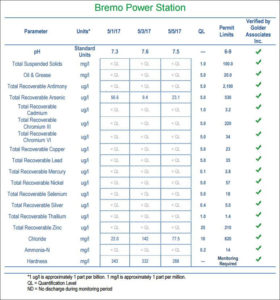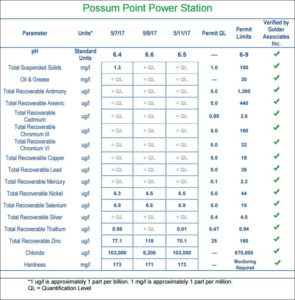
Bremo Power Station de-watering test results. Click for legible image.
Environmental controversies are flying so fast and furious in Virginia these days that it’s hard to keep track of them all. As for last year’s disputations, they are quickly forgotten. Remember, for instance, the wrangling over Dominion Energy’s plans for de-watering coal ash ponds at its Bremo and Possum Point power stations?
After intense negotiations, riverkeeper groups, the Southern Environmental Law Center, Dominion, and the Department of Environmental Quality settled upon a protocol for treating and monitoring the quality of effluent before it entered the James River and Quantico Creek. How has the arrangement worked out? The absence of headlines this year is one clue. The water-testing results posted on Dominion’s website provide another.
The tests, which cover pH, suspended solids, oil & grease, hardness and 15 heavy metals and other compounds, show that the water treatment process is cleaning the water to the point where the presence of most pollutants is impossible to detect.
At the Bremo station, only arsenic and chloride appeared in measurable quantities among the three samples taken in early May, and the concentration of both chemicals is less than one-tenth of the Environmental Protection Agency’s permit levels.

Possum Point power station de-watering test results. (Click for larger image.)
At Possum Point, five chemicals appear in large enough quantities to be detectable, but all are safely within prescribed bounds. One chemical, thallium, nudges up close to the permit limit but does not go over.
I don’t purport to have any expertise in these matters, but it looks as if the arrangement is working as it should. If you want to browse through a year’s worth of test results, click here.
This is far from the end of the story, of course. Dominion still must obtain permits for de-watering its Chesapeake and Chesterfield facilities. The results at Bremo and Possum Point suggest that Dominion has the de-watering process firmly under control.
However, the company has yet to receive solid-waste permits for disposing of the coal ash after it has been de-watered. Dominion wants to pursue a cap-in-place approach while environmental groups want the utility to bury the material in landfills. That issue will take longer to resolve. Among the uncertainties is determining the extent to which underground water picks up contaminants while migrating through the coal ash pits. Getting answers will require a different testing protocol than the one used for the de-watering process.


